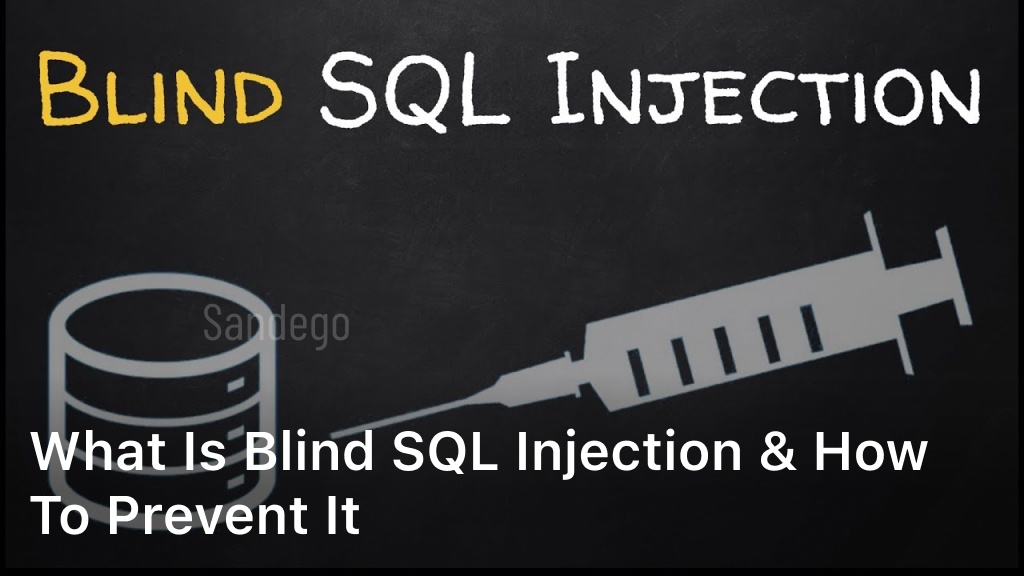Blind SQL injection is a type of SQL injection attack that targets web applications vulnerable to exploitable code injections in SQL statements. This attack is used by hackers to retrieve sensitive data or execute unauthorized commands on a database without the user’s knowledge. Blind SQL injection attacks occur when the vulnerable web application does not generate an error message, making it difficult to detect a malicious attack. In this section, we will delve into the concept of blind SQL injection and discuss the various types and techniques used in SQL injection attacks that make it challenging to prevent.
It is crucial to understand the vulnerability that allows blind SQL injection to occur and adopt preventive measures to secure your web application and protect sensitive information from being compromised. In the next sections, we will discuss best practices and various tools available to avoid blind SQL injection vulnerabilites in your web application and enhance its security.
Stay tuned to learn more about how to prevent SQL injection and safeguard your web application against these stealthy cyber threats!
Understanding SQL Injection Attacks

SQL injection attacks are a type of cyber attack that takes advantage of vulnerabilities in web applications. Hackers can use SQL injection to execute malicious SQL statements and gain access to sensitive data, alter database records, or even take control of the server.
There are different techniques used by attackers to exploit SQL injection vulnerabilities, such as input validation attacks and union attacks. Blind SQL injection is particularly stealthy and difficult to detect, as it does not provide any visible error messages.
To prevent SQL injection attacks, it is critical to implement proper input validation and query parameterization techniques. Additionally, using secure coding practices and adopting a vigilant approach to web security is essential.
By understanding how SQL injection attacks work and the potential impact they can have on a web application, you can implement the necessary measures to secure your database and prevent SQL injection attacks.
Types of SQL Injection
SQL injection attacks can be carried out using various techniques, including the infamous blind SQL injection. Blind SQL injection is a method where the attacker sends SQL queries to the database, and it’s often used with a tool that guesses the output of the SQL query.
Attackers can use several blind SQL injection techniques to extract sensitive information from databases, such as boolean-based, time-based, and error-based. Boolean-based blind SQL injection sends a query and records the response to determine whether the query is true or false. Time-based blind SQL injection often causes the database to delay its response, leading the attacker to deduce crucial information. Error-based blind SQL injection relies on the error messages returned by the database.
It’s essential to stay vigilant to the common attacks. Below is a cheat sheet that can help you identify and prevent blind SQL injection attacks:
- Use prepared statements or parameterized queries to avoid SQL injection.
- Filter user input with server-side validation.
- Limit user permissions to what is required.
- Encrypt sensitive data to restrict data access.
- Use a web application firewall to monitor traffic and block suspicious activities.
Understanding SQL Injection Vulnerability
SQL injection vulnerability is a significant risk for web applications. Hackers use vulnerabilities in input validation and query construction to launch SQL injection attacks, exposing sensitive data. Proper input validation and query parameterization are essential preventive measures.
When accepting user input, it is crucial to be cautious of any un-sanitized or unchecked data. Inputs in forms should be matched with their expected format using pattern-based validation. Additionally, input fields should have appropriate size limits to prevent overflows of data. To prevent SQL injection attacks, query parameters should always be parameterized. Parameter binding is a technique for defining parameters separately from the query, ensuring data is encapsulated and cannot be exploited.
By understanding how SQL injection attackers exploit these vulnerabilities, web developers can take steps to improve web application security. By preventing SQL injection, we can ensure that our web application is safe from even the most sophisticated cyber attacks.
Preventing Blind SQL Injection
To prevent blind SQL injection attacks, input validation is crucial. You can use whitelisting or blacklisting techniques to ensure that only valid inputs are accepted and processed. Another best practice to prevent blind SQL injection attacks is the use of parameterization. This involves separating the SQL query and the user input, preventing malicious code from being executed.
Secure coding practices can also help prevent blind SQL injection attacks. It is important to sanitize all user input and ensure that the input values do not interfere with the structure of the SQL query. Additionally, you can use stored procedures to insert, update, or retrieve data from the database, reducing the risk of SQL injection vulnerabilities.
To fortify your web application against blind SQL injection, we will go through a step-by-step tutorial. This will show how you can implement input validation and parameterization techniques, effectively preventing blind SQL injection attacks. By following this tutorial, you can ensure that your web application is secure and protected from potential threats.
Examples of Blind SQL Injection
Blind SQL injection attacks can have critical consequences for your web application. To illustrate the techniques used by hackers, let’s take a look at some real-life examples.
Example 1:
An attacker sends input that is not correctly validated by the web application. The SQL query constructed by the application is vulnerable to injection. The attacker then sends input that modifies the query to extract data from the database. The attacker can use this technique to retrieve sensitive information such as credit card numbers, banking details, and other personal information.
Example 2:
In this example, the attacker sends input to the web application that triggers a delay in its response. The attacker can then infer information about the database merely by observing the response times. For instance, the attacker might be able to determine whether a given query is true or false, or whether a particular field contains certain data.
These examples demonstrate how even minor vulnerabilities can be exploited by hackers using blind SQL injection techniques. Failure to address SQL injection vulnerabilities can lead to significant consequences for web application owners and their users. Keep reading to learn how you can prevent blind SQL injection attacks.
Tools for Detecting and Preventing Blind SQL Injection
There are many tools and technologies available to help detect and prevent blind SQL injection, both open-source and commercial. One popular open-source tool is SQLMap, which automates the process of detecting and exploiting SQL injection flaws. Another frequently used tool is Acunetix, a commercial product that offers a comprehensive web application security scanner capable of detecting and mitigating blind SQL injection threats.
When choosing a blind SQL injection tool, it’s important to consider a few factors, such as compatibility, accuracy, usability, and support. Some top commercial tools include IBM Security AppScan, Qualys Web Application Scanning, and HP WebInspect.
Ultimately, the right tool will depend on your specific needs and resources. It’s important to research and evaluate your options carefully before making a decision. By utilizing the right tools, you can enhance your web application security and mitigate the risk of blind SQL injection.
Conclusion
In conclusion, blind SQL injection attacks are a real and persistent threat to web applications. These stealthy attacks can wreak havoc on your databases, steal sensitive data, and damage your reputation. Therefore, it is essential to remain vigilant and take proactive measures to prevent SQL injection vulnerabilities.
Remember to adopt secure coding practices, implement proper input validation, and use parameterized queries to minimize the risk of SQL injection attacks. Employing the right tools and technologies can also help detect and prevent these attacks, giving you added peace of mind.
Stay informed, stay safe, and keep your web application secure from blind SQL injection. Thank you for reading!
FAQ
What is blind SQL injection and how can it be prevented?
Blind SQL injection is a technique used by hackers to exploit vulnerabilities in web applications. It involves injecting malicious SQL statements into input fields or query parameters, which can then be executed by the database server. This allows attackers to extract sensitive information from the database or manipulate its contents. To prevent blind SQL injection, it is essential to implement proper input validation, parameterization, and secure coding practices. Regular security audits and testing, along with the use of specialized tools, can also help identify and mitigate blind SQL injection vulnerabilities.
What are the types of SQL injection attacks?
SQL injection attacks come in various forms, including classic SQL injection, time-based blind SQL injection, error-based SQL injection, and Union-based SQL injection. However, blind SQL injection is especially stealthy and difficult to detect. In blind SQL injection, the attacker sends crafted SQL queries to the server and analyzed the response, typically boolean-based or time-based, to infer information about the database structure and data. This type of attack is often automated and can lead to data theft, unauthorized access, and even remote code execution.
How does SQL injection vulnerability occur?
SQL injection vulnerability occurs when an application does not properly validate user-supplied input or has insufficient input parameterization. This allows an attacker to inject malicious SQL statements into the application’s database query, thereby manipulating its behavior. The vulnerability can exist in various parts of the application, such as login forms, search fields, or comment sections. By exploiting this vulnerability, attackers can bypass authentication, discover sensitive data, modify or delete data, or even execute arbitrary commands on the database server.
How can blind SQL injection be prevented?
Preventing blind SQL injection requires a combination of defensive measures. These include implementing strict input validation, ensuring proper parameterization of query statements, and employing secure coding practices. Developers should avoid using concatenated SQL statements and instead use prepared statements or parameterized queries. Additionally, regular security audits and penetration testing can help identify and fix potential blind SQL injection vulnerabilities. The use of web application firewalls (WAFs) and specialized tools that detect and prevent blind SQL injection can also provide an extra layer of security.
Can you provide an example of blind SQL injection?
Sure! Let’s say there’s a login form on a website that uses the following SQL statement to authenticate users: “`sql SELECT * FROM users WHERE username = ‘john’ AND password = ” “` An attacker could use blind SQL injection to bypass the authentication by injecting a statement that always returns true, such as: “`sql SELECT * FROM users WHERE username = ‘john’ AND ‘1’=’1′ “` This would allow the attacker to log in without needing a valid username or password. By manipulating the injected SQL statements and analyzing the server’s response, attackers can gain unauthorized access and extract sensitive data from the database.
Are there any tools available to detect and prevent blind SQL injection?
Yes, there are various tools and technologies available to help detect and prevent blind SQL injection. Some popular open-source tools include SQLmap, Havij, and Skipfish. These tools can automate the process of identifying blind SQL injection vulnerabilities and provide insights into the database structure and data. Additionally, commercial web application firewalls (WAFs) like ModSecurity and Imperva provide protection against SQL injection attacks, including blind SQL injection. It is important to choose the right tool based on your specific needs and conduct regular vulnerability assessments to stay protected.






